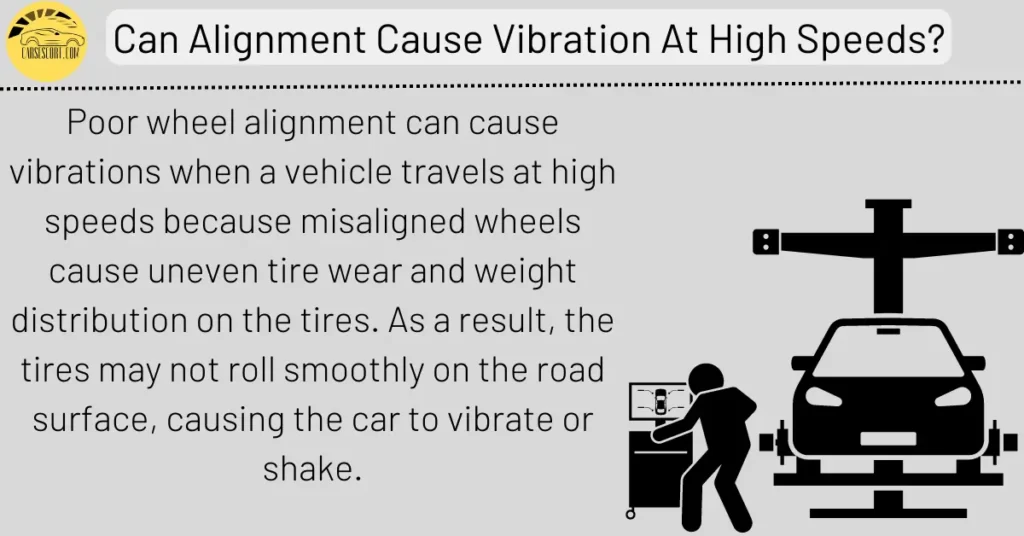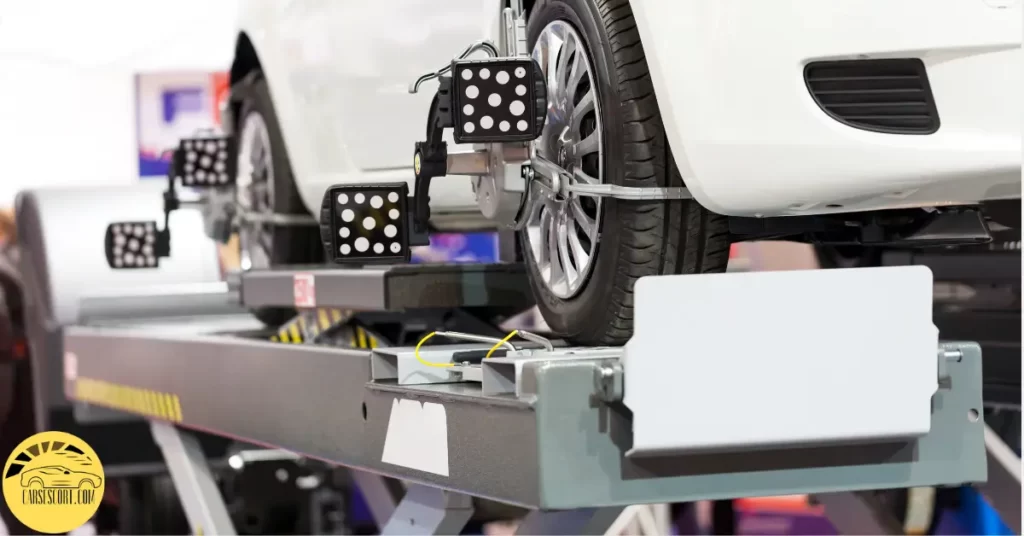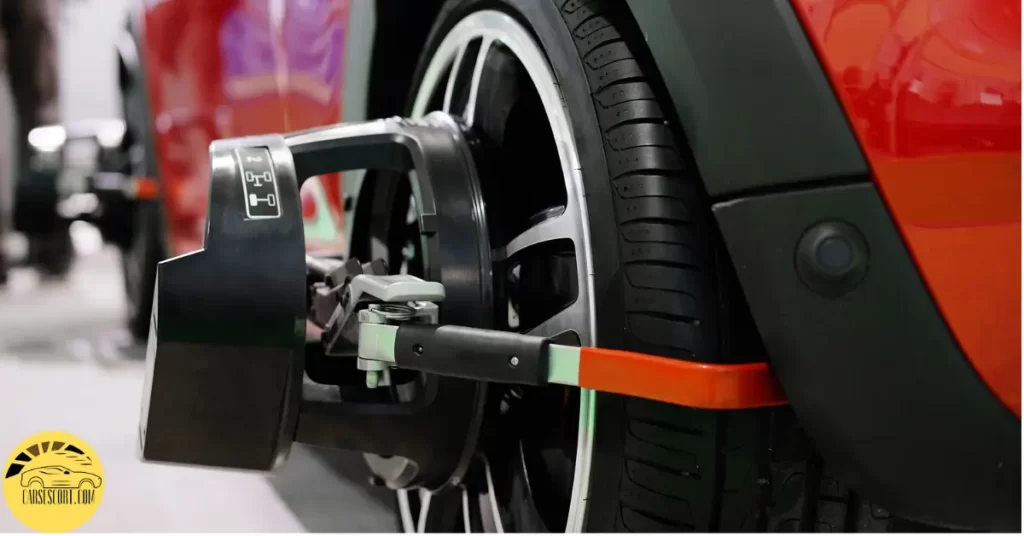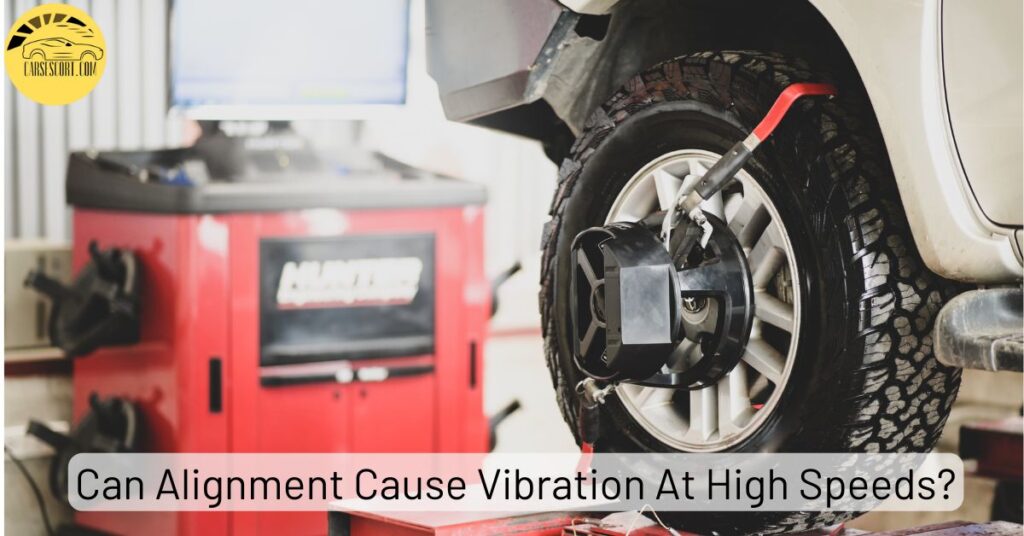Vehicle Alignment is a crucial aspect of vehicle maintenance and control that ensures safe and efficient driving. However, even with proper alignment, you may experience unexpected issues. Proper alignment is essential for a vehicle’s handling, tire wear, and overall safety. Despite the benefits of proper alignment, there are situations where unexpected issues may arise due to bad alignment. So can alignment cause vibration at high speeds?
Yes, poor alignment can cause vibrations at high speeds in vehicles. If the wheels and suspension are not properly aligned, it can lead to vibrations, uneven wear on the tires, and a shaking steering wheel.
One of the most concerning issues drivers may experience is car shaking at high speeds. These vibrations can be felt in the steering wheel, seats, and floorboards, making it difficult to control the vehicle.
Understand Good and Bad Alignment
Good alignment refers to properly positioning a vehicle’s wheels and suspension system components relative to each other and the vehicle’s frame.
Proper alignment ensures that the wheels are all pointed in the correct direction, parallel, and adequately centered within the wheel wells. A properly aligned vehicle will handle well, have even tire wear, and be more fuel-efficient.
Bad alignment refers to misaligned wheels and suspension system components that can occur due to various factors, such as hitting a curb, a pothole, or an accident.
Symptoms of poor wheel alignment can include uneven tire wear, the vehicle pulling to one side, steering wheel vibration, and decreased fuel efficiency.
Can Alignment Cause Vibration At High Speeds?
Poor wheel alignment can cause vibrations when a vehicle travels at high speeds because misaligned wheels cause uneven tire wear and weight distribution on the tires. As a result, the tires may not roll smoothly on the road surface, causing the car to vibrate or shake.
Other factors that can cause car shaking at high speeds include imbalanced tires, worn suspension components, compromised brake calipers, brake pedal and damaged or bent wheels.
It’s essential to have your vehicle regularly inspected and maintained to ensure wheels are balanced properly and avoid potential safety issues.

Why is Proper Alignment Essential?
Proper alignment is essential for a vehicle’s handling, tire wear, and overall safety. Tire alignment involves adjusting the angles of the wheels to ensure that they are parallel and perpendicular to each other and the road surface.
This alignment helps distribute the vehicle’s weight evenly, ensuring a smooth and stable ride.
Despite the benefits of proper alignment, there are situations where unexpected issues may arise due to poor alignment.
For example, hitting a curb or pothole can knock your wheels out of alignment, leading to wheel wear and a less comfortable ride.
Over time, normal wear and tear can cause the alignment to shift, resulting in issues such as pulling to one side of the road or vibrations in the steering wheel.
Signs of Bad Alignment
- Vehicle pulling to one side or the other while driving on a straight road.
- Uneven or rapid tire wear, especially on one side of the vehicle.
- Steering wheel vibration or off-center steering wheel while driving.
- Squealing tires while driving, especially when turning.
- Crooked or off-center steering wheel when the vehicle is driving straight.
- Reduced fuel efficiency, meaning you need to fill up more frequently than usual.
- Feeling a sense of looseness, shaking or wandering while driving, especially at higher speeds.

Common Wheel Alignment Issues
1) Issue With Angle of Camber
Camber refers to the angle of the wheels relative to the vertical axis. Positive camber means the top of the wheels tilts outward, while negative camber means the top tilts inward.
2) Toe Angle Problems
Toe refers to the angle of the wheels relative to the horizontal axis. Toe-in means the front of the wheels points inward, while toe-out means the front of the wheels points outward.
3) Steering Caster Issues
Caster refers to the angle of the vehicle steering axis relative to the vertical axis. The incorrect caster can cause steering instability, car shaking and poor handling.
4) Misaligned Thrust Angle
Thrust angle refers to the angle of the rear wheels relative to the vehicle centerline. A misaligned thrust angle can cause the vehicle to pull to one side.
5) Steering Wheel Off-Center
If the steering wheel is not centered when driving straight ahead, it can be a sign of misaligned wheels.
6) Uneven Tire Wear
Misaligned wheels can lead to uneven wheels wear and premature tire failure, reduced traction, and poor handling.
Can You Fix Tire Alignment Issues?
If you suspect car vibrating or car tires are out of alignment, the best course of action is to take your vehicle to a qualified mechanic or tire specialist for a wheel alignment.
During the alignment, the technician will use equipment to measure the misleading alignment and adjust the angles of your vehicle’s wheels to ensure they are appropriately aligned.
Proper tire alignment will help improve your vehicle’s handling, braking system prevent premature wheel wear, and improve your gas mileage.

How To Fix Alignment Cause Vibration At High Speed.
- Check tire pressure: Ensure all tires are inflated to the recommended pressure levels specified in the vehicle’s owner manual. Uneven tire pressure can cause the vehicle to pull to one side, leading to vibrations and tire imbalance.
- Check wheel balance: Wheels can become unbalanced over time due to wear and tear. A professional mechanic can balance the wheels by adding weights to the rim that helps distribute weight evenly and prevent car shakes.
- Inspect suspension components: Worn or damaged components such as shocks, struts, and bushings can cause vibrations. Inspect these components and replace any that are worn or damaged.
- Adjust wheel alignment: If the above steps do not solve the problem, the wheels may need to be realigned. A professional mechanic can adjust the wheel alignment angles to ensure they are perpendicular to the ground and parallel.
- Test drive: After making any adjustments, take the vehicle for a test drive to ensure the vibrations have been eliminated. If the problem persists, it may be necessary to consult a professional mechanic for further diagnosis.
You May Also Like To Read Some More Informative Article From Our Cars Guide:
Other Causes Of Steering Wheel Shake And Vibrations
Steering wheel shake and vibrations can be caused by various factors, not just wheel alignment issues. Here are some other common causes of steering wheel shake and vibrations:
1) Unbalanced wheels and tires
If the wheels and tires are not correctly balanced, or having bad wheel bearing it can cause vibrations at certain speeds, which can be felt in the steering wheel.
2) Worn suspension components
Worn suspension components, such as ball joints, tie rods, and bushings, can cause the wheels to move out of alignment, leading to steering wheel shakes and vibrations.
3) Worn or damaged brake components
Worn or damaged brake components, such as brake rotors or brake pads, can cause vibrations in the steering wheel when braking and full the vehicle to one side, reduce braking performance and cause uneven wheel wear.
4) Wheel bearings
Worn or damaged wheel bearings can cause vibrations in the steering wheel, especially at higher speeds. It can also cause the wheels to wobble, produce a humming or grinding noise, and affect the vehicle’s handling.
5) Engine problems
Spark plugs and engine problems, such as misfiring cylinders, can cause vibrations throughout the vehicle, including in the steering wheel.
It can also cause reduced power, decreased fuel efficiency, and rough idle.
FAQ
Can Uneven Tire Wear Cause Vibration?
Yes, uneven tire wear can cause vibration while driving. When the tires wear unevenly, they will no longer be balanced, which can cause a vibration in the vehicle.
Why Does My Car Shake At High Speed?
There are several reasons cars shake at high speeds. One common reason is an imbalance in the tires. If the tires are not correctly balanced, it can cause a vibration felt at high speeds. Another possible cause is worn suspension components, such as struts or shocks, which can cause the car to bounce or vibrate. It is also possible that the wheels are out of alignment, causing the car to shake or pull to one side.
Can You Fix Warped Brake Rotors?
Yes, warped brake rotors can be fixed. On some occasions, the rotors can be resurfaced, which involves removing a small amount of metal from the surface of the rotor to create a smooth, even surface. In more severe cases, the rotors may need to be replaced entirely if you are experiencing issues with your brakes, such as pulsation or vibration when braking.
What are the Signs of Unbalanced Tires?
Unbalanced tires can cause several symptoms, including vibration while driving, particularly at higher speeds. Other signs of unbalanced tires can include uneven tire wear, which can be seen as bald spots or excessive wear on specific areas of the tire. You may also notice that your car pulls to one side while driving or that the steering wheel shakes or vibrates.
My Final Thoughts
Can alignment cause vibration at high speeds? Yes, Poor wheel alignment can cause significant vibrations and shaking in your car, which can negatively affect your driving experience and potentially damage valuable components of your vehicle. Ignoring the issue can lead to uneven tire wear, which can result in the need for costly tire replacements.
The constant vibrations can cause damage to the steering and suspension systems, further increasing repair costs.
Affiliate Disclosure: Cars Escort is a participant in the Amazon Services LLC Associates Program. As an Amazon Associate, we earn from qualifying purchases made through affiliate links on our site. Read Our Disclaimer .

